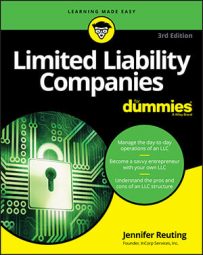All states have guidelines that dictate the management and ownership structure of a limited liability company (LLC), and they may seem a bit rigid. Unfortunately, if more people read their state statutes, they would realize how lax these statutes really are.
Although the default laws can be undesirable, the states allow the majority of them to be overridden by custom rules built into the company’s operating agreement, thus (again) making the LLC the most flexible entity around.
No ownership restrictions
Back in the day, if you wanted liability protection and a form of pass-through taxation, you were resigned to forming an S corporation. S corporations are just basic corporations with a special tax election that you can file with the IRS. Unfortunately, they also come with severe limitations as to the number and types of owners the business may have.
For example, S corporations are limited to 100 or fewer owners (shareholders), and these owners cannot be other companies or non–U.S. citizens. Additionally, they can have only one class of ownership — meaning that all owners must be treated equally.
LLCs, on the other hand, have no such problems. You can issue as many shares as you want to any other entity or individual of any nationality. (However, as individual as your pets may be, they don’t count!) You can also structure the ownership however you like using membership classes.
You can give preference to certain owners when it comes to profit distributions, or you can allow some owners certain voting rights that others don’t get.
LLCs also offer a lot of leeway as to how individual ownership is structured. For example, each member can be subject to his own buy-sell agreement that dictates the rules and restrictions on his individual membership interest, including what should happen to that member’s interest should he pass away or get a divorce. These rules can vary from member to member if you so choose.
No management restrictions
When it comes to the management of the business, an LLC can be managed by
Its members: When you select member management for your LLC, all of the business’s members have an equal say in the day-to-day operations, no matter their ownership percentage (unless you state otherwise in the operating agreement).
They all have an equal right to sign contracts and enter into debts on behalf of the business. If you don’t want one of your members to have this sort of power, then member management is definitely not for you.
Separate managers: These folks may or may not hold a stake in the company. Most companies that have more than two or three operating members choose manager management. When you elect manager management, you can have as many of your members be managers as you want; however, not all of them have to be managers if you don’t want them to be.
For example, say you are raising money for your new enterprise. Although you want your investors to profit from the business’s success, you don’t want them to have a say in the day-to-day operations. To achieve this, you form a manager-managed LLC and elect yourself as the only manager.
As members without management authority, the investors have limited say in the day-to-day operations of the business. This is a really good strategy for creative projects like movies as a way to keep the investors from running wild on the set.
When establishing your LLC, you state in your articles of organization whether your company will be designated member-managed or manager-managed.
Most states give you heaps of leeway in prescribing exactly how your company is managed. You can create multiple management groups and multiple management roles. You can also restrict some nonmanaging members from voting or having any say whatsoever, including who is chosen to manage the company. All these types of details are up to your discretion and simply need to be laid out in the LLC’s operating agreement.
The fact that you can specify separate managers is a trademark of LLCs that helps separate them from other entities, such as sole proprietorships and general partnerships. In a general partnership, all the members are owners, and all are equally (and personally!) liable for the business. A limited partnership can have members who also manage the business; however, it doesn’t have any sort of limited liability protection.
The management aspect is one reason LLCs work well in estate planning. You can place your assets in an LLC with the kids as the full owners (members) and yourself as the manager. This way, you still control the company, while your kids can receive profit distributions. Upon your death, the assets are still in their name, and a new manager is elected.
LLCs are definitely not one size fits all; they need to be customized to your particular business needs. All this customization happens in the operating agreement, making it the most important document you’ll ever write in regard to your business. If you don’t have an operating agreement, your state’s default rules apply.
This doesn’t mean that you should pull up a shoddy fill-in-the-blank operating agreement on the Internet and use that, either. Those generic forms are mostly antiquated, are not state specific, and likely won’t address all your needs.

